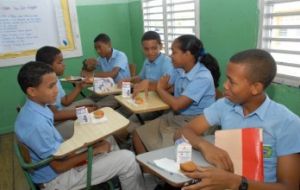MercoPress. South Atlantic News Agency
UN Latam economic commission publishes Yearbook with updated stats on the region
 ECLAC stats show some improvements in social indexes, but still mucho more is needed in education, health and housing
ECLAC stats show some improvements in social indexes, but still mucho more is needed in education, health and housing In Latin America and the Caribbean 94% of primary-school age children attended school, but the figure was down to 75% for secondary level of education. Likewise the average number of people on technical or university courses was three times higher in the richest quintile than in the poorest quintile, according to data collected by the Economic Commission for Latin America and the Caribbean (ECLAC).
The new edition of the “Statistical Yearbook for Latin America and the Caribbean 2012” includes valuable information on gaps in the population's education levels and between socio-economic groups, as well as other relevant figures describing the economic, social and environmental development of the region's countries.
The annual publication updates the statistical series of indicators in these areas and includes a considerable amount of existing information.
In the economic and social field, for instance, the 2012 report shows an increasingly striking downward trend in the energy intensity of GDP. This means that countries require smaller volumes of (renewable and non-renewable) energy to produce a monetary unit of production. Between 1990 and 2011, the amount went down from 1.42 to 1.28 in the region.
The document also includes relevant data on the region's economic reality, such as per capita GDP, which make it possible to carry out international comparisons and time analyses for each and every country.
As in previous issues, the Statistical Yearbook 2012 is organized into four chapters: Demographic and social aspects: population, employment, gender, education and health indicators; Economic statistics providing information on price indices, international trade, balance of payments and national accounts; Information on the environment and natural resources, organized under topics such as biota, water, forests, energy and environmental management and Methodological aspects relating to data sources, definition and coverage.
Most of the information comes directly from National Statistical Offices, Central Banks and other official institutions from member countries.




Top Comments
Disclaimer & comment rulesCommenting for this story is now closed.
If you have a Facebook account, become a fan and comment on our Facebook Page!